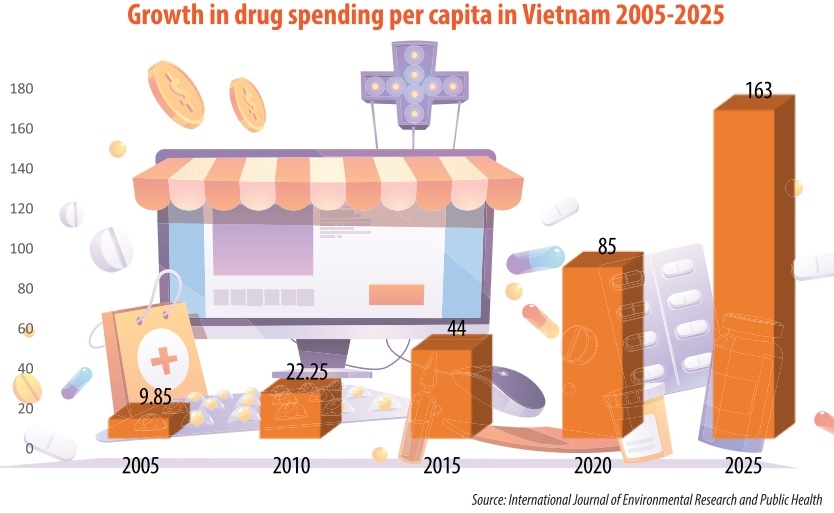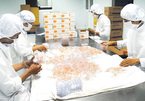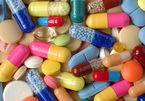Clearly in a happy mood, Vu Thi Thuan, chairwoman of Traphaco JSC, is looking towards a bright future in 2021 on the back of good performance last year.
“The pharmaceutical market has been affected by COVID-19. However, we made encouraging results thanks to having the right strategy,” Thuan told VIR.
 |
New tactics
Last year marked a hard 12 months for businesses, and Vietnamese-run pharma firms were not an exception, although the impacts on them have turned out to be less serious than in other sectors.
Faults in the global ingredient supply chain and lower purchasing power have prompted Vietnamese drugmakers to make changes to business plans to shelter from the storm and maintain growth.
Nguyen Vu Cuong, an analyst at brokerage and investment advisory firm FPT Securities, told VIR, “Some players in the pharma industry obtained improvements in operations in the last months of last year, while some others saw no growth, but no falls either. Improvements are mainly attributed to effective cuts in intermediary costs and the launch of new products and strategies.”
For instance, while focusing on the over-the-counter (OTC) market Traphaco also started to venture into the $3-billion beverage market last summer with a new product - herbal tea Traphaco Boganic, which was included in its revenue structure in the third quarter.
Le Trung Thanh, former general director of Pepsi Vietnam, said that in the local lucrative beverage market, players tend to create specific and unique products to gain an advantage. The market has many kinds of drinks, but not so many healthy ones.
“Healthy products are very popular in the US, the EU, Japan, and South Korea,” Thanh noted. “This is a courageous move from Traphaco because obviously drugs and beverages are not the same thing.”
A new bold step into the beverage market illustrates the challenge Traphaco has to attain new successes amid growing competition. Despite being a leading brand in the local pharma industry, making up nearly 50 per cent of market share of liver-tonic products for example, the group has not achieved better growth as it did in the past, despite having taken a number of major decisions.
Encouraging results came when Traphaco reported total revenues of over VND1.3 trillion ($56.52 million) and after-tax profit of VND141 billion ($6.13 million) in the first nine months of 2020, up 12 and 31 per cent on year, respectively – a strong performance in comparison with a fall of about 10 per cent among other listed drugmakers.
Elsewhere, Hau Giang Pharmaceutical JSC (DHG), the biggest domestic publicly-traded drugmaker, has trended towards the ethical drugs channel (ETC), or the hospital channel, and increased capacity for exports. The company has restructured its product portfolio towards focusing on investment in high-quality drugs meeting JAPAN-GMP and PICS-GMP standards.
DHG decided to pour $40 million in a GMP factory in the Mekong Delta province of An Giang, with the target to put it into operation in 2023. Also last year, DHG got the JAPAN-GMP certificate for its two assemblies. Drugs meeting JAPAN-GMP, PIC/S-GMP, EU-GMP, CGMP-USA certificates are among the prioritised in drug tenders for the hospital channel.
With the move, DHG showed off its ambition to conquer the strict Japanese market and some ASEAN member countries where subsidiaries of Taisho Pharmaceutical Holdings have presence. Taisho, one of the five biggest pharmaceuticals in Japan, is a major foreign shareholder of DHG, with a take of 50.78 per cent.
Imexpharm Pharmaceutical JSC, Vietnam’s fourth-biggest pharma firm, has similar focus on the ETC segment. The drugmaker has made investments to gain an EU-GMP certificate for its factories to gain advantages in drug tenders. During the past year it also restructured its product portfolio, concentrating on EU-GMP drugs.
Notably, Imexpharm gained market authorisation from Spain for its Cephalexin 500mg capsules produced at its EU-GMP factory located in the southern province of Binh Duong.
To serve the future strategy, a resolution from Imexpharm’s board of directors was issued on January 5 approving a loan of $8 million from the Asian Development Bank. At present, Imexpharm’s foreign ownership limit currently remains set at 49 per cent, with Balestrand Ltd. (5.92 per cent), and KWE Beteiligungen AG (14.26 per cent) as foreign shareholders.
Like Traphaco, Imexpharm, and DHG, OPC Pharmaceutical JSC – one of the biggest domestic pharma firms – and others had to make adjustment in its business strategy during the last year. OPC also suffered from interruptions in the global ingredient supply chain, although it has growing areas to supply for itself.
At present, Vietnam’s pharmaceutical production relies much on imported ingredients which make up 80-90 per cent of local demands, with which China and India account for over 80 per cent.
OPC focuses on expanding in functional food by investing in product assembly, while increasing production of alcohol-related products and others to satisfy growing demands due to the pandemic. Moreover, the company continued to strengthen the ETC channel as well as develop in the OTC market.
As noted in documents from OPC’s annual general shareholder meeting last June, some new businesses were added, including functional food, cosmetics, import and export of pharmaceuticals and ingredients, and automobile cargo transportation business.
Good performance
With year-end reviews and financial statements imminent, results for these pharma firms are just around the corner. According to a source from TRA, the group is estimated to see an on-year increase of 11 per cent in revenues by end-2020. Its profit is also estimated to rise at the same rate, reaching VND200 billion ($8.7 million).
While reporting a fall in the ETC market, Traphaco gained a 17 per cent on-year improvement in OTC.
“We aim to have consolidated revenue ascended by 9 per cent in 2021, with the OTC to be the key channel, and ETC to rise 10 per cent,” Thuan told VIR.
With the change in business strategy, DHG’s net revenues just slightly fell by 2.8 per cent on-year in the first three quarters of 2020, while after-tax profit rose 24 per cent, fulfilling the annual targets. It is said to meet the 2020 targets.
Having been reporting better performance after the mid-year peak of COVID-19 in Vietnam, Imexpharm saw net revenues and profit rise 0.8 and 17.8 per cent in the first 11 months, respectively. Its ETC revenues jumped 40 per cent on-year, while OTC is on the road to recovery despite a negative growth of 10 per cent.
Market watchers attributed Imexpharm’s higher profit growth to better performance of cost saving, with selling and management expenses cutting by 8.6 and 5.4 per cent, respectively. With this momentum, Imexpharm is one of the giants forecast to report growth in its results.
According to Fitch Solutions, revenues of Vietnam’s pharma industry were estimated at $6.5 billion in 2019. The Drug Administration of Vietnam forecast promising double-digit growth for the industry over the next five years, with the total value to reach $7.7 billion in 2021 and a likely rise to $16.1 billion in 2026.
In the wake of growth potential, multinational corporations are expanding towards and within the local market – a trend that should be further intensified on the back of the EU-Vietnam Free Trade Agreement. This will create more pressures on the domestic players, urging them to make new changes to stand firm and spur growth. VIR
Bich Thuy

Support for domestic pharmaceutical industry to rise in Vietnam
The Vietnamese Government's support for the local pharmaceutical industry will remain steadfast, according to Fitch Solutions.

VN pharmaceutical market: stiff competition fosters M&A wave
Vietnam ranks 17th among 'pharmerging' markets, or markets expected to become a ‘pillar’ for the world’s pharmaceutical industry, according to IMS Health.